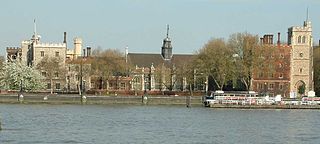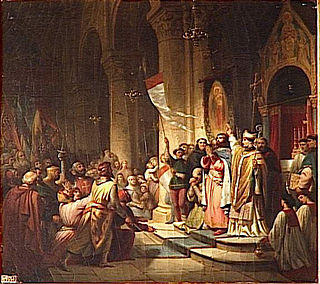Boniface I might refer to:
- Pope Boniface I (died 422)
- Boniface I, Margrave of Tuscany (died 823)
- Boniface I, Marquess of Montferrat (died 1052)
- Bonifacio I (1888–1954), King of the Afro-Bolivian monarchy
Boniface I might refer to:

Pope Boniface I was the bishop of Rome from 28 December 418 to his death on 4 September 422. His election was disputed by the supporters of Eulalius until the dispute was settled by Emperor Honorius. Boniface was active in maintaining church discipline, and he restored certain privileges to the metropolitical sees of Narbonne and Vienne, exempting them from any subjection to the primacy of Arles. He was a contemporary of Augustine of Hippo, who dedicated to him some of his works.
Pope Boniface III was the bishop of Rome from 19 February 607 to his death. Despite his short pontificate, he made a significant contribution to the Catholic Church.
Pope Boniface IV, OSB was the bishop of Rome from 608 to his death. Boniface had served as a deacon under Pope Gregory I, and like his mentor, he ran the Lateran Palace as a monastery. As pope, he encouraged monasticism. With imperial permission, he converted the Pantheon into a church. In 610, he conferred with Bishop Mellitus of London regarding the needs of the English Church. He is venerated as a saint in the Catholic Church with a universal feast day on 8 May.
Pope Boniface V was the bishop of Rome from 23 December 619 to his death. He did much for the Christianisation of Anglo-Saxon England, and enacted the decree by which churches became places of sanctuary.
Pope Boniface VI was the bishop of Rome and ruler of the Papal States in April 896. He was a native of Rome. His election came about as a result of riots soon after the death of Pope Formosus. Prior to his reign, he had twice incurred a sentence of deprivation of orders as a subdeacon and as a priest. After a pontificate of fifteen days, he is said by some to have died of the gout, by others to have been forcibly ejected to make way for Stephen VI, the candidate of the Spoletan party.

Pope Boniface VIII, born Benedetto Caetani was the head of the Catholic Church and ruler of the Papal States from 24 December 1294 until his death in 1303. The Caetani family was of baronial origin, with connections to the papacy. He succeeded Pope Celestine V, who had abdicated from the papal throne. Boniface spent his early career abroad in diplomatic roles.

Pope Boniface IX was head of the Catholic Church from 2 November 1389 to his death, in October 1404. He was the second Roman pope of the Western Schism. During this time the Avignon claimants, Clement VII and Benedict XIII, maintained the Roman Curia in Avignon, under the protection of the French monarchy. He is the last pope to date to take on the pontifical name "Boniface".
Pope Gregory II was the bishop of Rome from 19 May 715 to his death. His defiance of Emperor Leo III the Isaurian as a result of the iconoclastic controversy in the Eastern Empire prepared the way for a long series of revolts, schisms, and civil wars that eventually led to the establishment of the temporal power of the popes.

Pope Gregory III was the bishop of Rome from 11 February 731 to his death. His pontificate, like that of his predecessor, was disturbed by Byzantine iconoclasm and the advance of the Lombards, in which he invoked the intervention of Charles Martel, although ultimately in vain. He was the last Pope to seek the consent of the Byzantine exarch of Ravenna for his election, and of Syrian origin, the last non-European pope until the election of Pope Francis more than 1,271 years later in 2013.

Boniface was an English Benedictine monk and leading figure in the Anglo-Saxon mission to the Germanic parts of Francia during the eighth century. He organised significant foundations of the church in Germany and was made bishop of Mainz by Pope Gregory III. He was martyred in Frisia in 754, along with 52 others, and his remains were returned to Fulda, where they rest in a sarcophagus which remains a site of Christian pilgrimage.

Year 607 (DCVII) was a common year starting on Sunday of the Julian calendar. The denomination 607 for this year has been used since the early medieval period, when the Anno Domini calendar era became the prevalent method in Europe for naming years.
Pope Damasus II was the Bishop of Rome and ruler of the Papal States from 17 July 1048 to his death on 9 August that same year. He was the second of the German pontiffs nominated by Emperor Henry III. A native of Bavaria, he was the third German to become pope and had one of the shortest papal reigns.

Boniface of Savoy was a medieval Bishop of Belley in Savoy and Archbishop of Canterbury in England. He was the son of Thomas, Count of Savoy and owed his initial ecclesiastical posts to his father. Other members of his family were also clergymen, and a brother succeeded his father as count. One niece Eleanor of Provence was married to King Henry III of England, and another was married to King Louis IX of France. It was Henry who secured Boniface's election as Archbishop, and throughout his tenure of that office, he spent much time on the continent. He clashed with his bishops, with his nephew-by-marriage, and with the papacy but managed to eliminate the archiepiscopal debt that he had inherited on taking office. During Simon de Montfort's struggle with King Henry, Boniface initially helped Montfort's cause but later supported the king. After his death in Savoy, his tomb became the object of a cult, and he was eventually beatified in 1839.

Boniface I, usually known as Boniface of Montferrat, was the ninth Marquis of Montferrat, a leader of the Fourth Crusade (1201–04) and the king of Thessalonica.

Saint Lullus was the first permanent archbishop of Mainz, succeeding Saint Boniface, and first abbot of the Benedictine Hersfeld Abbey. He is historiographically considered the first official sovereign of the Electorate of Mainz.
There have been eight popes and one antipope named Boniface.
Boniface is a given name and a surname of Latin origin, meaning "fortunate, auspicious". The best known of those who bear the name is Saint Boniface, an important leader in early Christianity and the "Apostle of the Germans". Others named Boniface include:
Benedetto Caetani may refer to:

Raimbaut de Vaqueiras or Vaqueyras was a Provençal troubadour and, later in his life, knight. His life was spent mainly in Italian courts until 1203, when he joined the Fourth Crusade. His writings, particularly the so-called Epic Letter, form an important commentary on the politics of the Latin Empire in its earliest years. Vaqueiras's works include a multilingual poem, Eras quan vey verdeyar where he used French, Italian, Galician-Portuguese and Gascon, together with his own Provençal.
Boniface of Tuscany may refer to: